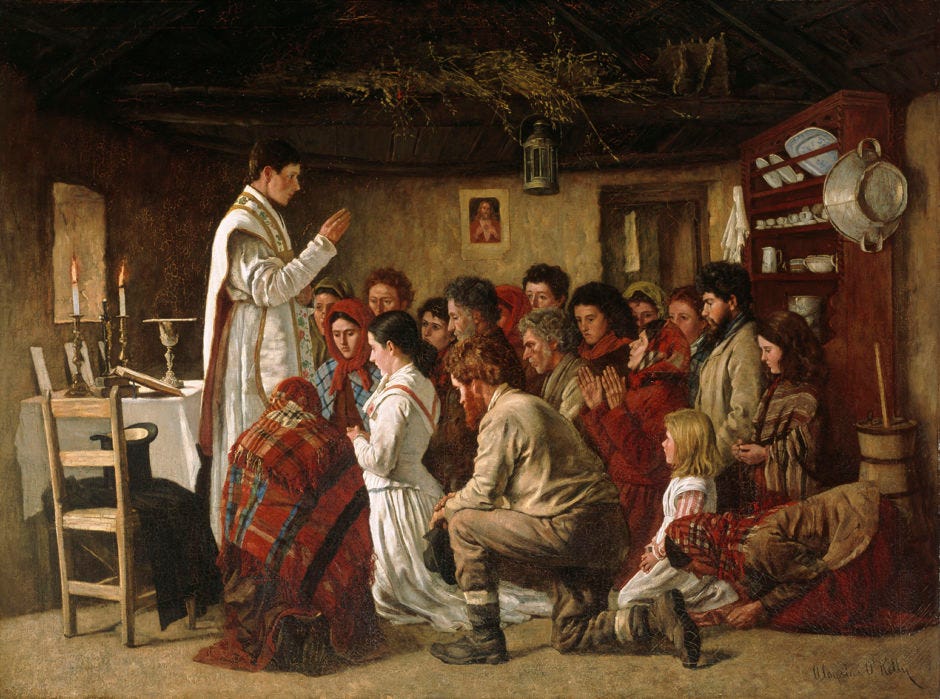Are Your Pews Filling With Young and New Christians?
A Christian revival is underway on several fronts. Does your church reflect it?
There are three partly overlapping Christian revivals underway across the world. Thankfully, they are very far removed from the Todd Bentley-style “revival”, aka blasphemy circus. You can summarize the three trends as follows:
High-profile celebrity conversions, mainly to Roman Catholicism.
A newfound willingness to identify as Christian in public situations previously deemed risky or even off limits.
A wave of youngsters—skewing male—seeking out confessional liturgical worship.
Does your congregation reflect these revival trends in its recent membership gains?
Celebrity Conversions
There has been a notable uptick in announced Christian conversions by celebrities and intellectuals. The number of converts to Roman Catholicism should cause deep introspection for LCMS Lutherans - what about the RC brand is so attractive? Conversion examples include:
Actor Russell Brand (RC).
Vice President JD Vance (RC).
Billionaire and former vice presidential running mate of Robert F. Kennedy Jr. Nicole Shanahan (Non-Denom).
Activist Ayaan Hirsi and her husband Niall Ferguson, the famous historian (Anglican).
Tammy Peterson, wife of celebrity Jungian psychoanalyst Jordan Peterson (RC).
Media commentator Candance Owens (RC).
Wikipedia co-founder Larry Sanger (See comment below - has not declared for any denomination).
Only Fans prostitute Nala Ray (Non-Denom Evangelical).
Navy SEAL and media commentator Shawn Ryan (Non-Denom Evangelical)
NBA player AJ Griffin (Non-Denom Evangelical).
Actor Shia LaBeouf (RC).
Professional surfer and shark attack victim Bethany Hamilton (LCMS Lutheran)
Author Adam B. Coleman (Non-Denom Evangelical?)
Pop star Justin Bieber (Non-Denom Evangelical)
Media commentator Eva Vlaardingerbroek (RC).
Protestant YouTuber Cameron Bertuzzi (RC).
French comedian Gad Elmaleh (RC)
Atheist pro-life activist Kristin Turner (RC).
Historian Tom Holland (RC).
Public Square Christianity
The conversions listed above are notable for being very public proclamations and discussions, which is appropriate - Scripture is filled with public celebrations and thankfulness for the gift of grace.
Consequently, there has been an observable increase in public square conversations about religious faith generally and Christianity specifically. A tangential driver has been The Chosen television series. It has profound theological problems, but there is no denying that it has helped restore a buffer zone for civil public conversations about Christianity.
A similar effect can be discerned in various podcasts, like the Tucker Carlson Show. Carlson has been open about a shallow appreciation of Christianity despite marrying the daughter of an Episcopalian priest. He recently started reading the Bible cover-to-cover and had something of a personal conversion, acknowledging that the God he encountered in the text is real, active, and present. However, Carlson could benefit from a confessional pastoral intervention given his confusion about monergism and synergism and the promotion of the Hallow App, which carries an unhealthy load of heterodox mystical practices.
Likewise, YouTuber Shawn Ryan is an open Christian convert but has a dangerous fascination with the occult, such as “remote viewing” by mediums. There is some commonality with media commentator Mike Cernovich (converted to Eastern Orthodoxy), who also became a Christian after taking an ayahuasca trip, during which he says he interacted with demons. Ryan was suffering from addiction and PTSD until a psychedelic “healing” with 5-MeO-DMT and ibogaine.
God is clear that mediums and the spirits they conjure, including those manifesting through drug psychosis, are demons under the command of the Devil.1
Young, Restless, and Confessional
Another trend is the swell of young men and women joining confessional liturgical churches.
The movement is dominated by young men who are scathing of the Longhouse churches and culture they grew up in. They were spiritually anesthetized by ersatz worship services defined by casually attired pastors, in-house barista marketing lures, entertainment-oriented church bands bathed in moving-head wash lights, and anonymity facilitated by mass attendance settings and “campus models.”
At the same time, society has been dragging and scolding men, especially whites, as toxic and deserving of discrimination. As a result, those men are happy to make the relentless criticism and alienation a self-fulfilling prophecy by leaning into it. They are sincere and intentional about their faith, demonstrate a deep and complex interest in theology, are bellicose against their parents' flimsy cultural Christianity, and are sympathetic to Christian Nativism/Nationalism.
Eastern Orthodox churches have been the primary beneficiaries as men respond positively to the denomination’s masculine projection, bold aesthetics, and claim to authentic originalism. A 2023 survey by the Orthodox Studies Institute of Orthodox clergy in 20 parishes across 15 states found an 80% increase in converts to the Orthodox church in 2022 compared with pre-pandemic levels in 2019. 60% of the converts were men, especially single men.
The ruling elite’s response has been to dismiss these young men as lacking agency and being radicalized into escalating anti-social attitudes and behaviors. They are disparaged as gullible consumers of “manosphere” and “bro culture” media, which has steered them to embrace ever more “toxic masculinity” headlined by the likes of Jordan Peterson, Joe Rogan, or Andrew Tate. However, none of those accused puppet masters have recommended men go to church…
The Lutherans
Confessional and liturgical Lutheran churches have also enjoyed an influx of young men and women, which is part of an overall trend that has arrested the long-term decline in Christian affiliation in the US.
The youngsters drive considerable distances and make sacrifices to attend, passing many churches on their way to worship services rooted in the historic liturgy and hymnody. One common theme is that when they “test drive” churches with segregated traditional and contemporary services, the traditional services have tiny, aged attendees. Consequently, the youngsters keep moving, and anecdotal evidence shows them settling in single-service liturgical congregations with expanding cohorts of 20-30-year-olds that provide social and friendship connections and prospective spouse opportunities.
Parts of the LCMS seem unnerved by the young men. This is unsurprising because the Synod also mirrors its national cultural context, which is distrustful of and cynical about young men, especially when they wear crucifixes visibly and proudly. Likewise, the Synod seems more inclined to be hospitable to heavily tattooed single mothers than pious young ladies sporting mantillas, hoping to mother several braces of unvaccinated tallow-fed children and who are hostile to female ordination.
Other parts of the Synod have embraced these youngsters and the shifting zeitgeist around the orders of creation. Rev. Dr. Jeff Hemmer has done a great job promoting healthy patriarchy and exhorting the church to engage our young men in, by, and through Christ. Gottesdienst is on the front lines, as is A Word Fitly Spoken. Rev. Jonathan Fisk has the Hebron Collegium, while events like the annual Men’s Gathering revive Christian male-only spaces. Young ladies and mothers are encouraged and engaged in the pursuits of Biblical womanhood, most visible in the “MAHA Mom” activities, as well as the homeschooling and classical schooling endeavors taking root around the large new families God is blessing the Synod with.
We need to remind and encourage our pastors that these youngsters are to be examined on their confession of faith, not the podcasts they listen to, the guns they collect, or the head coverings they accept or reject.
Our Synod is amid a tremendous opportunity to revitalize our congregations and do long-term demographic rehabilitation. Evangelize and catechize the youngsters, pair them, marry them, find them jobs, and baptize their many children!
☩TW☩
For example:
Give no regard to mediums and familiar spirits; do not seek after them, to be defiled by them: I am the Lord your God.
And the person who turns to mediums and familiar spirits, to prostitute himself with them, I will set My face against that person and cut him off from his people.
A man or a woman who is a medium, or who has familiar spirits, shall surely be put to death; they shall stone them with stones. Their blood shall be upon them.
[Manasseh] made his son pass through the fire, practiced soothsaying, used witchcraft, and consulted spiritists and mediums. He did much evil in the sight of the Lord, to provoke Him to anger.
So Saul died for his unfaithfulness which he had committed against the Lord, because he did not keep the word of the Lord, and also because he consulted a medium for guidance.
Then he goes and takes with him seven other spirits more wicked than himself, and they enter and dwell there; and the last state of that man is worse than the first.
Now the Spirit expressly says that in latter times some will depart from the faith, giving heed to deceiving spirits and doctrines of demons.
For they are spirits of demons, performing signs, which go out to the kings of the earth and of the whole world, to gather them to the battle of that great day of God Almighty.





Absolutely. Young people returning to liturgical, confessional churches aren’t just chasing tradition for tradition’s sake—they’re seeking a church that actually believes what it confesses. A church where the actions of worship align with the words of faith.
Does the pastor treat the body and blood of Christ as a holy mystery or a casual drive-thru meal? Do the hymns carry the weight of doctrine, or are they trimmed down for efficiency? These things matter because they reveal what a church truly believes.
If every aspect of the Divine Service is a confession, then the question is simple: Does this practice align with what we say we believe? Not as a legalistic checklist, but as a way to remain faithful. If the answer is consistently “no,” people notice—and they look elsewhere.
Good article. It's a great problem for all churches to solve high rates of apostasy. Most seem to leave because the temptations of the world are far more enticing than they ever have been. Converts to the different branches are mostly people that would have stayed if they found their home church was more true, essentially retention of true believers rather than new growth. Also it remains to be seen how long converts will last as their impression of the Church is tested against the Church in actuality. Many young men can get frustrated when they find the Church is not the cudgel against their political foes and the panacea to all their personal problems.